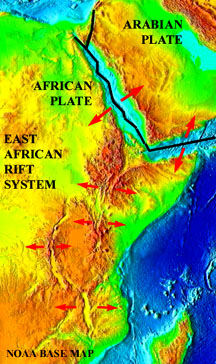|
|
BACK | NEXT |  |
|
|
STUDY QUESTIONS |
|
|
BACK | NEXT |  |
|
|
STUDY QUESTIONS |
|
Prior to the acceptance of plate tectonics, most of the large scale patterns found in oceans and on continents were unexplained, mostly because explanations were sought in surface processes. Today, we understand that because plates are in constant motion, most geological activity takes place along plate boundaries. Therefore they are the primary focus of our attention. There are three types of boundaries, depending on the relative motion of the plates: divergent, where plates come apart, convergent, where plates come together, and transform, where plates slide past each other. 
The earth is a giant heat engine that slowly dissipates its heat outward. In the upper mantle this heat, carried by rising, convecting materials in the asthenosphere, heats the lithosphere, which thins, expands, becomes less dense and therefore floats higher (rises). This raised lithosphere is what forms ridges. The stresses created by the rise and expansion crack the lithosphere, forming the rifts. The uplifted lithosphere then slides laterally. To what extent this lateral motion is due to gravity sliding (ridge push) or whether it is caused by the downward pull of the plate in zones where it is being recycled (slab pull) is still open to debate. This rifting process is not restricted to a particular type of lithosphere, but occurs in oceans as well as in continents. As the lithosphere slowly diverges, the rift widens, the underlying mantle materials melt and rise to fill the rift. This rift, where the plates diverge and volcanic activity takes place, is actually a very small area, only some 5 to 6 miles wide. As the lava solidifies, it acquires the prevalent magnetization pattern, and consequently a magnetic signature unique to the time of its formation. As the oceanic lithosphere continues to diverge, these newest zones of iron rich basalts are again and again ripped apart and carried outward, giving rise to the distinctive age and magnetic striping pattern of the ocean floor.
In sum, ridges and rifts mark the location of divergent boundaries between lithospheric plates and are characterized by the following: ·
|